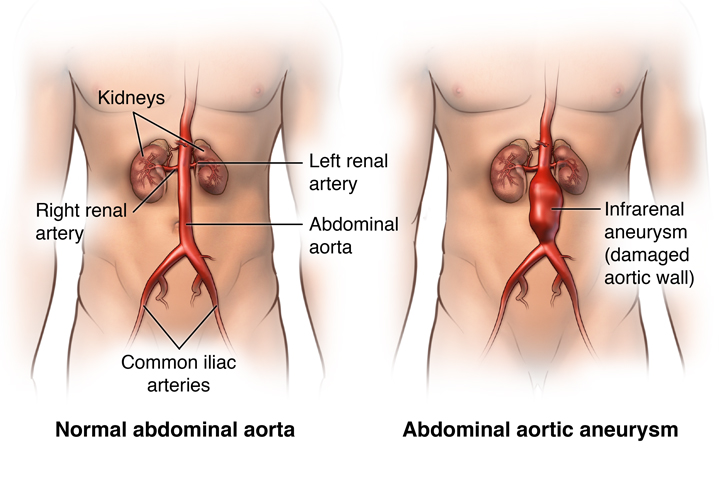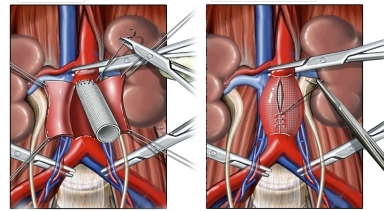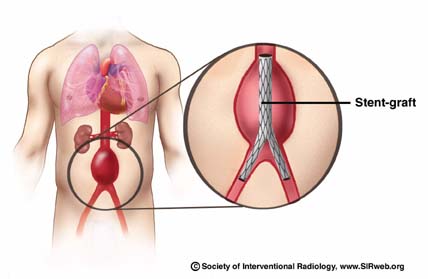An Abdominal Aortic Aneurysm (AAA) is caused by a weakened area in the main vessel that supplies blood from the heart to the rest of the body. When blood flows through the aorta, the pressure of the blood beats against the weakened wall, which then bulges like a balloon. If the balloon grows large enough, there is a danger that it will burst. Most commonly, aortic aneurysms occur in the portion of the vessel below the renal artery origins. The aneurysm may extend into the vessels supplying the hips and pelvis. Once an aneurysm reaches 5 cm in diameter, it is usually considered necessary to treat to prevent rupture.
AAA Prevalence
- Approximately one in every 250 people over the age of 50 will die of a ruptured AAA
- AAA affects as many as eight percent of people over the age of 65
- Males are four times more likely to have AAA than females
- AAA is the 17th leading cause of death in the United States, accounting for more than 15,000 deaths each year.
- Those at highest risk are males over the age of 60 who have ever smoked and/or who have a history of atherosclerosis (“hardening of the arteries”)
- 50 percent of patients with AAA who do not undergo treatment die of a rupture
Smoking is a Major Risk Factor for AAA and other Vascular Disease
- Those with a family history of AAA are at a higher risk (particularly if the relative with AAA was female)
- Smokers die four times more often from ruptured aneurysms than nonsmokers
AAA Symptoms
AAA is often called a “silent killer” because there are usually no obvious symptoms of the disease. Three out of four aneurysms show no symptoms at the time they are diagnosed. When symptoms are present, they may include:
- Abdominal pain (that may be constant or come and go)
- Pain in the lower back that may radiate to the buttocks, groin or legs
- The feeling of a “heartbeat” or pulse in the abdomen
Once the aneurysm bursts, symptoms include:
- Severe back or abdominal pain that begins suddenly
- Paleness
- Dry mouth/skin and excessive thirst
- Nausea and vomiting
- Signs of shock, such as shaking, dizziness, fainting, sweating, rapid heartbeat and sudden weakness
In some, but not all cases, AAA can be diagnosed by a physical examination in which the doctor feels the aneurysm as a soft mass in the abdomen (about the level of a belly button) that pulses with each heartbeat.
The most common test to diagnose AAA is ultrasound, a painless examination in which a device (a transducer) about the size of a computer mouse is passed over the abdomen. Sound waves are computerized to create “pictures” of the aorta and detect the presence of AAA. Other methods for determining the aneurysms’ size are CT scan (computerized tomography), MRI (magnetic resonance imaging), and arteriogram (real time x-rays).
AAA Treatments
Currently, there are three treatment options for AAA:
Watchful waiting – Small AAA’s (less than 5 centimeters or about 2 inches), which are not rapidly growing or causing symptoms, have a low incidence of rupture and often require no treatment other than “watchful waiting” under the guidance of a vascular disease specialist. This typically includes follow-up ultrasound exams at regular intervals to determine if the aneurysm has grown.
Surgical Repair – The most common treatment for a large, unruptured aneurysm is open surgical repair by a vascular surgeon. This procedure involves an incision from just below the breastbone to the top of the pubic bone. The surgeon then clamps off the aorta, cuts open the aneurysm and sews in a graft to act as a bridge for the blood flow. The blood flow then goes through the plastic graft and no longer allows the direct pulsation pressure of the blood to further expand the weak aorta wall.
Interventional Repair – This minimally invasive technique is performed by an interventional radiologist using imaging to guide the catheter and graft inside the patient’s artery. For the procedure, an incision is made in the skin at the groin through which a catheter is passed into the femoral artery and directed to the aortic aneurysm. Through the catheter, the physician passes a stent graft that is compressed into a small diameter within the catheter. The stent graft is advanced to the aneurysm, then opened, creating new walls in the blood vessel through which blood flows.
Benefits of Interventional Repair
- No abdominal surgical incision
- No sutures, or sutures only at the groins
- Faster recovery, shorter time in the hospital
- No general anesthesia in some cases
- Less pain
- Reduced complications
Disadvantages of Interventional Repair
- Possible movement of the graft after treatment, with blood flow into the aneurysm and resumption of risk of growth/rupture of the aneurysm
- Probable life-time requirement for follow-up studies to be sure the stent graft is continuing to function



